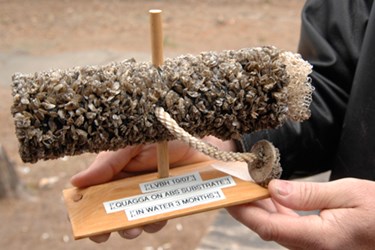California's Future Quagga-mire

By Artun Ereren
In the long list of issues that face the state of California, an aquatic species invasion isn’t likely to be a legislative priority. In the water world, an invasion of any kind means trouble for the industry. The problem isn’t so much about water quality; daily operations and important ecosystems will be affected. Clams roughly the size of a dime called quagga mussels have the potential to multiply and clog water intake structures. While they settle in, quagga mussels feed on important planktons that native organisms require to survive.
Originally from the Black Sea at the crossroads of Europe and Asia, the quagga and its smaller cousin, the zebra mussel, have a 200-year history of causing problems. Latching on to any surface they could find, quagga mussels forced Europeans to build structures away from invasions. By attaching on to the ballast tanks of boats, westward voyages eventually brought quagga mussels to North America. Minnesota has been wrestling with quagga mussels since 1988, costing the state up to $500 million dollars a year and more than 200,000 hours of maintenance. As of 2007, quagga mussels have entered the Colorado River system, infesting Lake Mead and Lake Mathews. For a state that will already experience a drop in revenue as a result of Governor Brown’s conservation mandate, the cost of controlling quagga mussel invasions will create economic obstacles for California and, more specifically, the Metropolitan Water District.
Operational issues in California have already begun. In Metropolitan’s 2008 Annual Report, quagga mussels forced an intake shutdown that lasted 11 days. Currently, the common defense against quagga mussels is sodium hypochlorite treatment near intakes. Low doses of chlorine are required because excess chlorination may create the cancer-causing pathogens called trihalomethanes (THMs). Disinfecting the quagga mussels by chlorine is just not a sustainable solution, and neither are 11-day maintenance procedures. In order for California to face this challenge head-on, the state must look upstream and see what else is being done. A San Diego-based biotech company called Marrone Bio has developed bacteria that specifically targets quagga mussels. The bacteria, called Zequanox, is composed of dead cells and is ingested by quagga mussels, ultimately eating them from the inside out. Zequanox is the only pesticide of its kind approved by the U.S. EPA. Crooked Lake in Michigan is the first open-water recipient of Zequanox; the cost is estimated to be $100,000 per acre. Whether or not California decides to go ahead with Zequanox, it must work with other Colorado River states to stop the problem upstream. Offspring of the quagga mussels are carried downstream and mature miles past the original sight of the invasion. It is not known if Zequanox has the capability to kill the offspring before quagga mussels mature, but eyes will be on Michigan as details develop.
In Canada, the governments of British Columbia have campaigns that educate Canadians on how to prevent quagga mussel outbreaks in their own lakes. Boats are thoroughly checked as part of the “Don’t Move A Mussel” campaign. The educational approach Canada took should be a component of the plan to fight quagga mussels in the Colorado River. An organization with a similar message called the 100th Meridian Initiative addressed the issues of invasive species in the western United States. As a possible homage to an explorer of the American West, John Wesley Powell, the 100th Meridian Initiative could be a platform for the western states and Canada to cooperate on water issues. In the meantime, it will be interesting to see how California agencies allocate the “clams” to fight off quagga mussels.
Artun Ereren is a firm believer of history’s role in science and vice versa. During his time at Cal State Fullerton, Artun researched topics ranging from water use in the Caucasus to present-day struggles in the education system. Blending his passion for water with his experience as an activist for education reform, Artun is now a Water Conservation Representative at Yorba Linda Water District.
